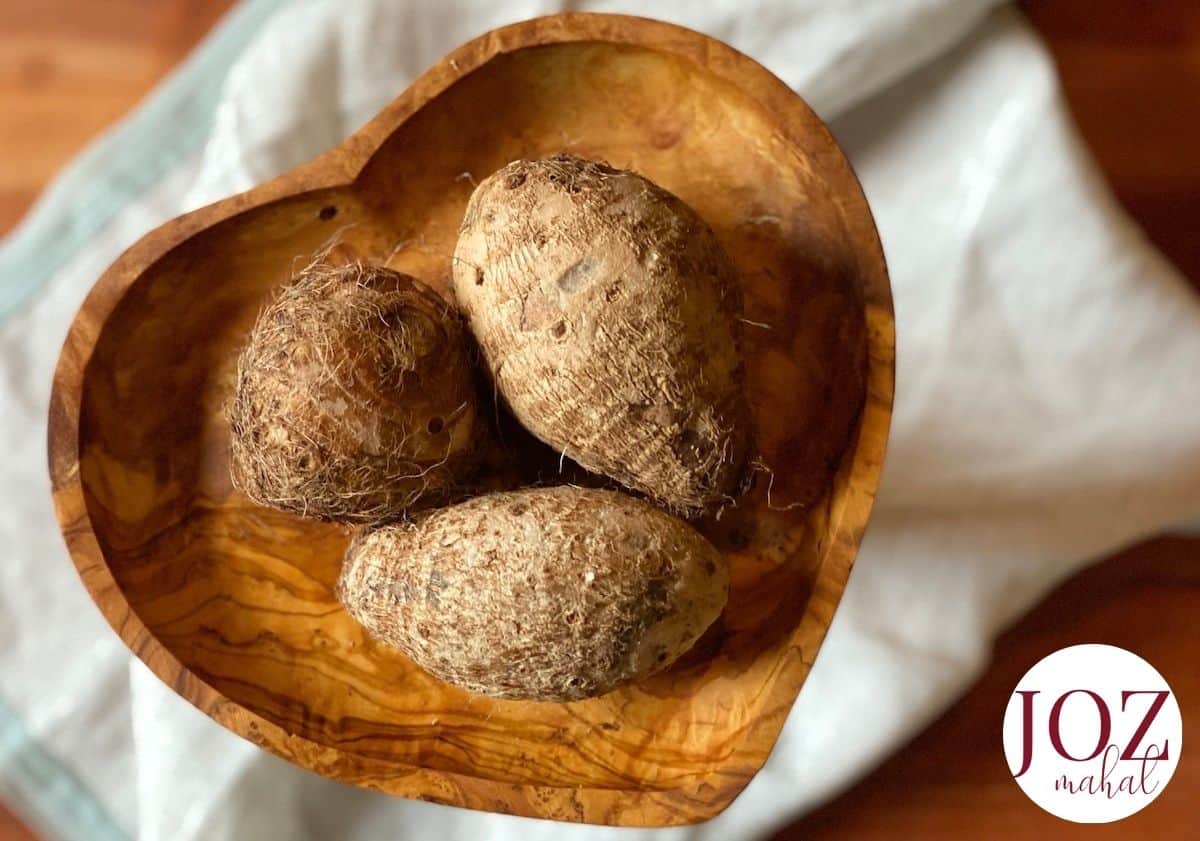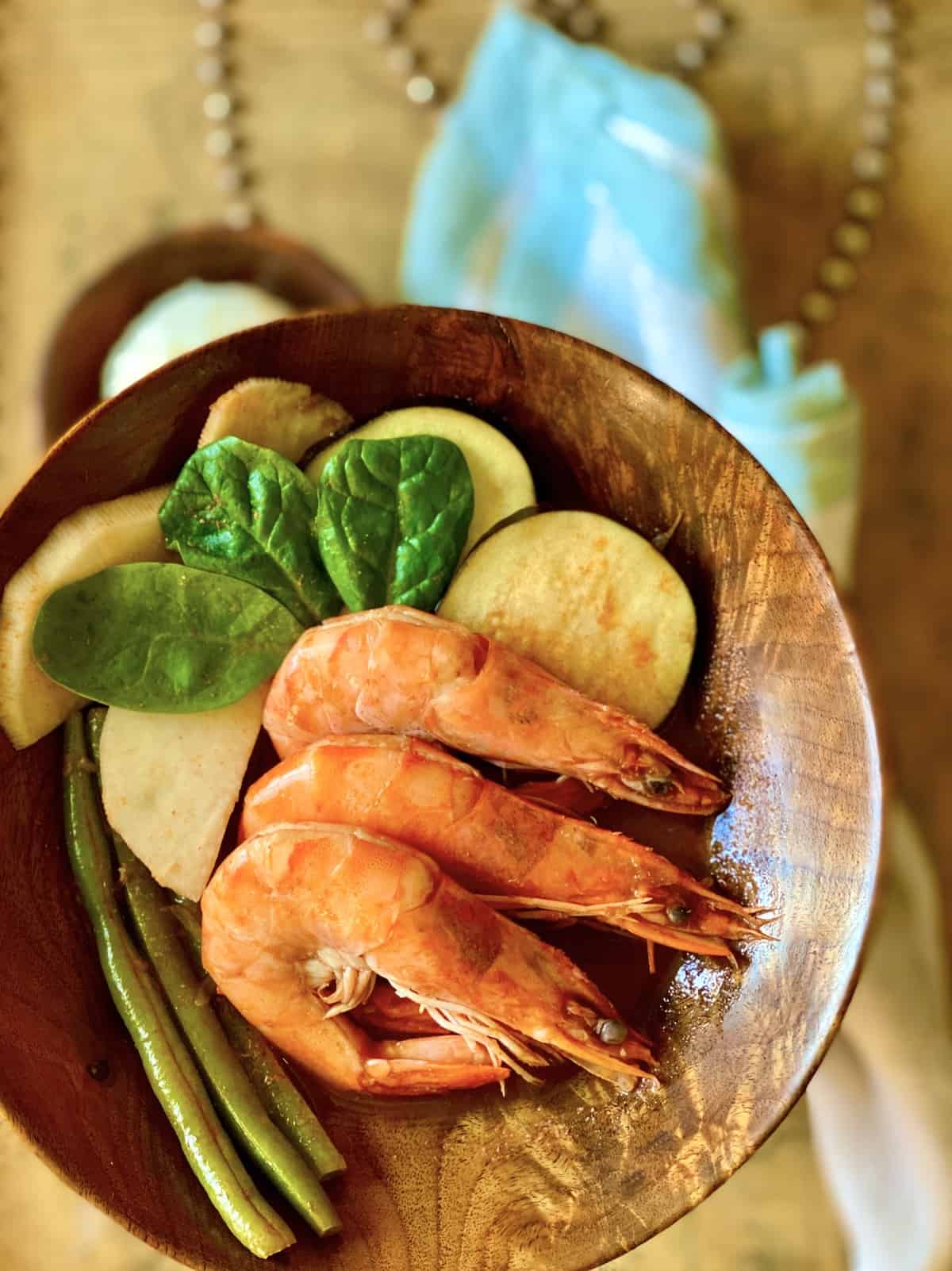If you love shrimp and soup with a sour note, then you will love the flavors of this delicious Filipino sour soup recipe. This shrimp sinigang with tamarind recipe is a great weeknight treat that takes only 20 minutes to cook. Let's not forget that sinigang soup is also a one-pot meal, making clean-up a breeze!
Jump to:
History of Shrimp Sinigang With Tamarind and Taro Root
Sinigang is a popular Filipino dish that has been enjoyed for generations. It's known for its tangy and savory flavors, making it a go-to comfort food for many Filipinos. But what's the story behind this delightful shrimp sinigang variation?
Traditionally, sinigang was cooked using souring agents like kamias (bilimbi fruit) or guava. However, over time, tamarind became the preferred choice due to its unique tartness and ability to add depth to the broth. Just imagine that tanginess dancing on your palate as you savor each spoonful of this aromatic soup.
Now let's talk about our seafood star - the shrimp! Shrimp sinigang adds a delectable twist to the classic recipe by incorporating succulent shrimp into the mix. These little crustaceans bring their own natural sweetness and subtle brininess that perfectly complements the rich flavors of the soup.
But wait...there's more! Taro root, also known as gabi in Filipino cuisine, gives this sinigang variety an earthy yet creamy texture that will make you want seconds (or thirds!). When cooked just right, taro root melts in your mouth, adding another layer of richness to the already flavorful broth.
So, overall, both tamarind and taro root gave this particular recipe a complex and balanced flavor, playing out the sourness and sweetness. You can find tamarind and taro roots in an Asian food market.
Ingredients

- Cooking oil: Any would work. I mostly always use olive oil.
- Shrimp: Fresh or frozen, unpeeled with heads on, or removed and peeled works.
- Souring Agent: I used tamarind concentrate.
- Variety of Vegetables: Tomato, Okra, Spinach, String Beans, Taro Root (Gabi), Lemon, and Eggplant. See "Substitutions and Variations" below.
- Chili Pepper and Fish Sauce: These are optional for added flavor. Fish sauce can be found in the Asian aisle at your local grocery store, or you can buy it online. I use Red Boat, 100 percent pure, first-press, "extra virgin" Vietnamese fish sauce. It's made from only two ingredients: the freshest black anchovy and sea salt. It's naturally Gluten-Free. Read the label, as some may contain wheat and MSG.
Substitutions and Variations
- Proteins: While shrimp is traditionally used in sinigang, switch it up with other seafood options like fish or crab. The tangy tamarind broth works wonders with any seafood, so don't be afraid to get creative. Other proteins can also work for sinigang, like beef, chicken, and pork being the most popular choice.
- Now, onto the tamarind itself – it adds that signature sourness to sinigang. And if you can't find fresh tamarind or don't have access to tamarind paste or tamarind mix, fret not! You can easily substitute it with other sour fruits, such as green mangoes or calamansi (Philippine lime). I have also used fresh squeezed lemon juice. These alternatives will bring a unique twist while keeping that delightful tanginess intact.
- Moving on to taro root – this starchy veggie gives sinigang its comforting texture. However, if taro root isn't readily available in your area or you prefer something else, try substituting it with potatoes or even sweet potatoes. Both options work beautifully and add their own distinct flavor profile.
- For those who are vegetarian or vegan, you can still enjoy the deliciousness of this dish by replacing shrimp with tofu or tempeh. They absorb all the wonderful flavors from the broth and provide a hearty protein alternative.
- Now let's talk about vegetables because they also play a crucial role in sinigang. Alongside taro root (or its substitutes), traditional veggies include tomatoes, onions, long beans (sitaw), radishes (labanos), and leafy greens like kangkong or spinach (water spinach). However, don't be afraid to toss in other vegetables you love – bok choy, okra, daikon radish, green beans, kang kong, eggplant, or even carrots. The beauty of sinigang lies in its versatility!
- Lastly, let's not forget the seasoning! Sinigang is typically soured with tamarind, but feel free to experiment with other souring agents like guava or lemon.
What is Taro Root and How Does It Taste Like
Taro root is a root vegetable that originated in Asia but is now enjoyed worldwide. Taro root is called gabi in the Philippines and has brown outer skin and white flesh with purple specks throughout. When cooked, it has a mildly sweet taste and a texture similar to a potato.
I used the taro root for flavorings and to add consistency to the soup. It gave the soup a little more depth texture and a layer of sweetness like a sweet potato.
So, overall, both tamarind and taro root gave this particular recipe a complex and balanced flavor, playing out the sourness and sweetness. You can find tamarind and taro roots in an Asian food market.

How to Cook This Filipino Favorite
- In a stockpot, add water, tamarind paste, and tomato. Bring water to a boil.
- Turn to a simmer, and add shrimp or prawns. Let simmer for 3 minutes. Be careful not to go over since we will add vegetables, giving the shrimp more cooking time.
- Add the vegetables: Taro Root, Eggplant, String beans, Okra, and Spinach. Cover and continue to simmer for an additional 2 or 3 minutes. Turn off and remove from heat.
- Serve immediately with steaming hot rice or nice crusty bread to sop up the Sinigang broth.
- Season with salt or fish sauce to taste.
Storage for Leftovers
First things first, let's address some common concerns when it comes to storing shrimp sinigang leftovers. Shrimp can be delicate, so handling them carefully during storage is important. Additionally, sinigang is a dish containing various ingredients like vegetables and broth that need proper attention.
So here are some friendly tips on how you can ensure your shrimp sinigang leftovers stay fresh and tasty:
- Cool It Down: Allow your shrimp sinigang to cool down before transferring it into any container or placing it in the refrigerator. This helps prevent bacteria growth and keeps the quality intact.
- Separate Solid Ingredients: If you have larger pieces of vegetables or seafood in your sinigang (besides shrimps), consider separating them from the soup broth before refrigerating. This helps maintain their texture better without getting too soggy.
- Choose Suitable Containers: Opt for airtight containers or resealable bags when storing your leftover shrimp sinigang. Ensure they are clean and dry beforehand, as moisture can lead to spoilage or unwanted odors.
- Refrigerate Promptly: Once cooled down, place your sinigang leftovers in the refrigerator as soon as possible – preferably within two hours after cooking – to keep them safe from bacterial growth.
- Label and Date: To avoid confusion later on, remember to label your containers with the storage date using stickers or markers. This way, you know exactly when they were stored and won't have to play any guessing games later on!
- Consume Within 2-3 Days: While shrimp sinigang leftovers can be stored in the refrigerator for up to three days, it's best to consume them within two days for optimal freshness and flavor.
Reheating Tips:
When reheating your leftover sinigang, gently warm it on the stovetop over low heat until thoroughly heated. Avoid overheating to prevent further cooking of delicate shrimp or vegetables that may result in texture loss.
Freezing Option:
- Individual Portion Freezing: If you prefer the convenience of having single servings ready to go, this method is perfect for you. Ladle your leftover shrimp sinigang into individual airtight containers or freezer bags. Make sure to leave some headspace as liquids expand when frozen. Label each container with the date and contents before popping them into the freezer.
- Family-Size Freezing: This option works wonders if you'd rather freeze larger portions for family meals. Transfer your remaining shrimp sinigang into a large airtight container suitable for freezing, ensuring enough space at the top for expansion during freezing. Attach a label indicating the dish and date before carefully placing it in the freezer.
- Ice Cube Tray Trick: This unconventional method is great for portioning out small shrimp sinigang broth or sauce for future use in other recipes like soups or stews. Pour cooled-down broth/sauce into ice cube trays and freeze until solidified. Once frozen, transfer these flavorful cubes into labeled freezer bags and store them conveniently in your freezer until needed.
Frequently Asked Questions
Shrimp sinigang is a popular Filipino soup dish with tangy tamarind broth, various vegetables, and succulent shrimp. It's known for its deliciously sour and savory flavor profile.
Absolutely! While fresh shrimp are fantastic if you have access to them, frozen ones work perfectly fine, too. Just make sure to thaw them thoroughly before adding them to your sinigang.
YES! Add green chili peppers to the broth to make the dish spicy.
The tamarind broth is what gives sinigang its tangy flavor. Add more tamarind soup base or fresh tamarind pulp if you prefer a more sour taste. Conversely, use less of these ingredients if you prefer a milder flavor.
Taro root, also known as gabi in Filipino cuisine, adds a unique texture and taste to shrimp sinigang. It becomes tender when cooked and absorbs the flavors of the broth beautifully.
You can usually find taro root at Asian grocery stores or well-stocked supermarkets. Look for firm roots with smooth skin - they should be somewhat hairy or fuzzy. Don't worry; that's completely normal!
Start by peeling the outer layer of the taro root using a vegetable peeler or knife. Then, slice it into cubes or chunks, depending on your preference. Remember to wear gloves while handling raw taro, as it may cause skin irritation for some individuals.
Yes! Check out my recipe for Pork Sinigang using the stovetop and Instant Pot.
Absolutely! Feel free to experiment with different veggies according to your taste preferences. Common additions include kangkong (water spinach), okra, eggplant, radish, and long beans. Get creative and make it your own!
Deveining shrimp is when you remove the black strip along the back of the shrimp. This is the shrimp's lower digestive tract. You'll find some sand and grit and the shrimp's digested food. Deveining the shrimp prior to cooking makes for a cleaner presentation of the shrimp. And you won't get that gritty texture when you bite into the shrimp.
Large shrimp would be ideal to make Shrimp Sinigang. I prefer to use 16-20-count size shrimp. That means you get about 16 to 20 shrimp per pound.
Other Sinigang and Soup recipes
If you make this recipe, post a photo using the hashtag #JOZmahal. Let's be taste buds and follow me on Facebook, Twitter, Instagram, and Pinterest.
📖 Recipe

Equipment
Ingredients
- 1 Tablespoon Olive Oil
- 1 ½ pound Shrimps or Prawns fresh or frozen
- 1 quart Water
- 1 Tomato sliced
- 1 Tablespoon Tamicon Tamarind Paste
- 1 2 Taro Root sliced
- 1 Eggplant sliced diagonally
- 1 cup String Beans
- 1 cup Okra
- 1 cup Spinach
- Juice of 1 Lemon
- Salt to taste
- Chili Pepper optional
- Fish Sauce optional
Instructions
- In a stockpot, add water, tamarind paste, and tomato. Bring water to a boil.
- Add shrimp or prawns and juice of one lemon. Let simmer for 3 minutes. Be careful not to go over, since we still need to cook the vegetables, which will give the shrimp more cooking time.
- Add Taro Root, Eggplant, String beans, Okra, and Spinach to the stockpot. Cover and continue to simmer for an additional 2 or 3 minutes. Turn off and remove from heat. Add salt or fish sauce to taste.
- Serve with rice or nice crusty bread to sop up the Sinigang broth.
Notes
- You can substitute prawns for the shrimp in this recipe. Depending on the size, the cooking times will vary and will be slightly more.
- You can also use fresh or frozen (peeled and headless) shrimp.
- If you can't find Taro Root, you can substitute parsnips, turnips, or rutabaga.
- You can substitute green beans for string beans.
Nutrition
Want more recipes? Go to recipe index to see other gourmet recipes sorted by category!






















Mae
For a soup that is so quick and easy to make, this sure was very tasty! I love the addition of gabi in the recipe. It gave the soup more body.